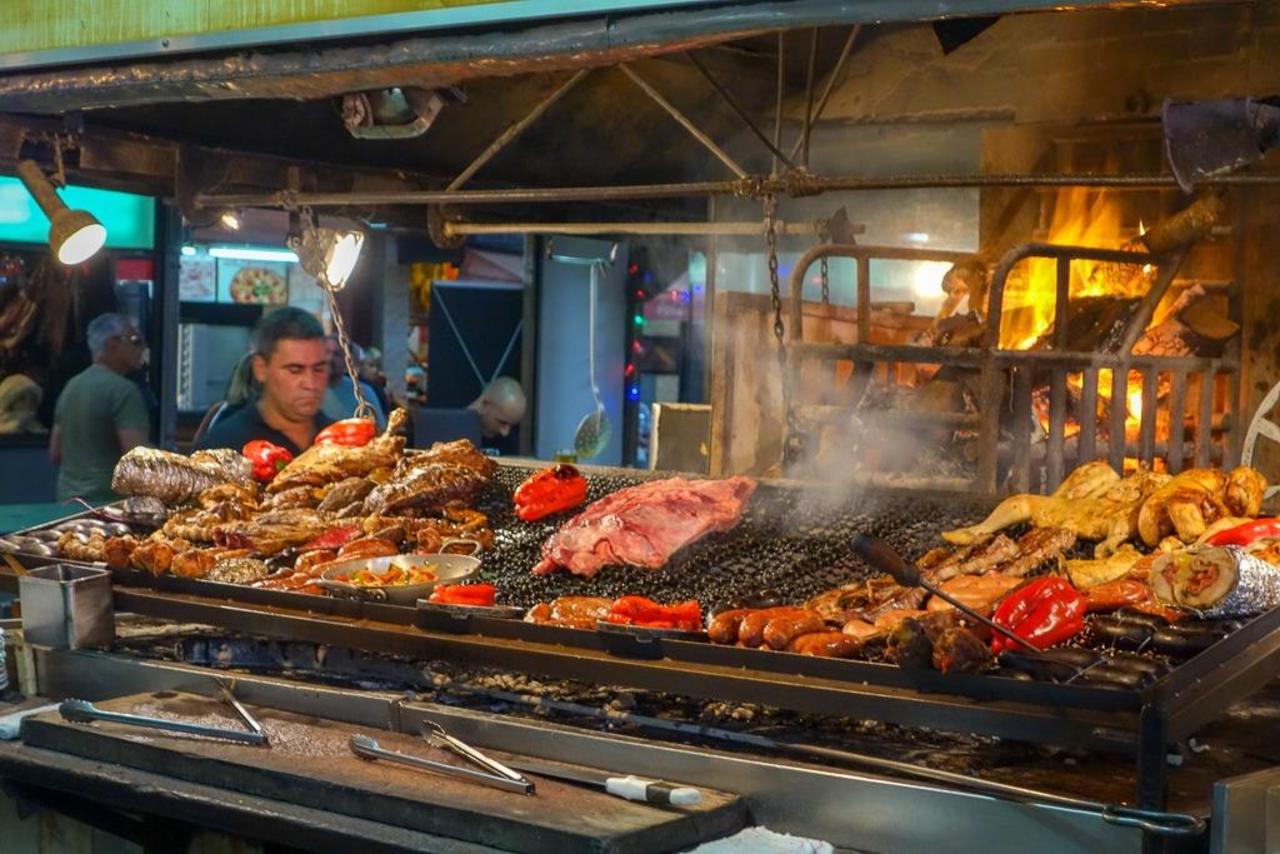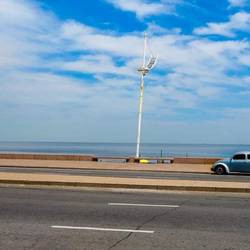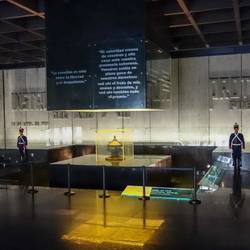Montevideo, Uruguay
 December 6, 2019 in Uruguay ⋅ ⛅ 21 °C
December 6, 2019 in Uruguay ⋅ ⛅ 21 °C
Viking Jupiter. 2 Tours Booked
Montevideo, Uruguay’s capital, is a major city along the Montevideo Bay. Population of Uruguay is 3 million people and Montevideo is one and a half million. It revolves around the Plaza de la Independencia, once home to a Spanish citadel. This plaza leads to Ciudad Vieja (the old town), with art deco buildings, colonial homes and landmarks including the towering Palacio Salvo and neoclassical performance hall Solís Theatre. The southernmost capital city in the Americas, Montevideo is situated on the southern coast of the country, on the northeastern bank of the Río de la Plata.
Montevideo enjoys a scenic setting on the estuary waters of the Plata River. The Portuguese were the first to settle here hoping to give them a strategic advantage near the open ocean. Between 1680 and 1683, Portugal founded the city of Colonia do Sacramento in the region across the bay from Buenos Aires. Within its walls some of the most impressive colonial era buildings were built, from the Parliamentary Legislative Council building to the stunning Montevideo Metropolitan Cathedral. The wall has long since disappeared, but the character of old Montevideo remains. Downtown amid modern skyscrapers, historic neo classical and art deco architecture provide more glimpses into the city’s past, and in the barrio (district) of Carrasco, picturesque private residences recall the posh neighbourhood’s days as a seaside resort.
This Portuguese city met with no resistance from the Spanish, already established in Buenos Aires, until 22 November 1723, Field Marshal Manuel de Freitas da Fonseca of Portugal built the Montevieu Fort. A Spanish expedition was sent from Buenos Aires and on 22 January 1724, the Spanish forced the Portuguese to abandon the location and started populating the city. It passed between Spain, Portugal, Britain and France over a period of 100 or so years. It became economically important in the mid 1800’s. During the May Revolution of 1810 and the subsequent uprising of the provinces of Rio de la Plata, the Spanish colonial government moved to Montevideo. During that year and the next, Uruguayan revolutionary José Gervasio Artigas 1764-1850 united with others from Buenos Aires against Spain. He was considered the liberator of Montevideo and became their hero.
In the morning we took A Panorama Tour of Montevideo with our guide Julio.
This was a bus tour starting at the Independencia Plaza, that separates Ciudad Vieja (Old Town) from downtown Montevideo, with the Gateway of The Citadel on one side and the beginning of 18 de Julio Avenue on the other. July 18, celebrates the first constitution in 1830. In the center, the Artigas Monument dominates the perspective, Artigas' remains are kept in an underground Mausoleum, opened in 1977, beneath his monument. We wandered around the square for about a half hour and then bused out to see the Legislative Council, an impressive building made of national marble. It is considered to be one of the most attractive parliamentary buildings in the world. Parliament has 80 senators 160 representatives, a president for 5 years who cannot be re-elected until out of office for five years.
We continued to Batlle Ordonez Park (Batlle is spelled correctly!) where we saw the La Carreta Monument. The Carreta was the traditional Uruguayan way to transport in the early days. The sculptor made the moulds in Uruguay but took them to Italy to be cast in bronze. Mussolini wanted to keep it, but the sculptor said no and brought it back to Uruguay.
We continued on to see the Centenario Stadium, built between 1929 and 1930 to host the inaugural 1930 FIFA World Cup, as well as to commemorate the centennial of Uruguay's first constitution. The normal capacity is 60,235, but the record attendance in 1930 was 79,987 (Uruguay vs-Yugoslavia). On our way back to the ship we drove along the upscale beach neighbourhood of Pocitos, a long stretch of palm tree- lined beaches lapped by the Plata River. We passed many upscale hotels and high-rises as we returned to port.
We hurried back for a quick lunch and then set out again for a 3-hour walking tour of Old Town (Ciudad Vieja) Montevideo. Our Guide was Santiago a teacher on a 3-month summer break. We were bussed to Independencia Plaza again to start our tour. Our guide led us to Palacio Salvo, the site was bought by the Salvo brothers.
The building was originally intended to be a hotel, but this plan didn't work out, and it has since been occupied by a mixture of offices and private residences. It was the tallest building in Latin America for a brief period.
While walking along the sidewalk looking at all the cast iron sculptures, Don posed with one like a piano player. Unfortunately, he moved forward and hit his shin on a part that stuck out. Ouch!! From there we crossed the plaza to see the monument to Uruguayan revolutionary José Gervasio Artigas. We went down into the Mausoleum, it was very beautifully done in marble. Our guide took us by several buildings that had sculptures in their main lobbies and one that had a number of photos of times in the past. We continued on foot to the Teatro Solis, Uruguay's most important and renowned theatre. It opened in 1856, designed by the Italian architect Carlo Zucchi, they claim it has excellent acoustics, probably not as good as Teatro Colon ,Buenos Aries.
We passed through the Gateway of The Citadel, the last of the existing walls of the old Fortress, to the cobbled streets in Old Town that were closed to vehicles. We continued through the Gateway of The Citadel, the last of the existing walls of the old Fortress, to the cobbled streets in Old Town that were closed to vehicles. We passed many street vendors with their tables filled with everything you could imagine, for sale. We continued on to Plaza de la Constitution also known as Plaza Matriz, the oldest plaza in Montevideo. It is located in the first part of the city that was built. We saw a lovely fountain monument and toured the interior of the 18th century Metropolitan Cathedral. At Zabala Square we learned that in 1878, during the dictatorship of Colonel Lorenzo Latorre, it was decided to demolish the old fort and build a public square in its place. The most important landmark in the square is the equestrian statue of Bruno Mauricio de Zabala, who founded Montevideo in 1724. We entered the Taranco Palace, erected on the site of Montevideo's first theatre in the historical centre of the city which had been built in 1793. The Taranco Ortiz family commissioned the construction of the building in 1907 and it was completed in 1910. In 1943 the Uruguayan state purchased the residence and part of the furniture and gained access to its works of art, but it wasn't until 1972 that it became a museum, and it was declared a National Historic Landmark in 1975.
We headed back to the ship noting the largest Uruguayan bank, opened in 1896. Our last stop was at the Mercado del Puerto. This building, constructed from steel, is one of Uruguay’s main attractions. It’s located in the older part of the city, right across from the port of Montevideo, and it was originally a market for fruit, vegetables, and meat. Today, it’s still called the “Harbor Market,” but there aren’t quite as many stalls and stands. Instead, it hosts a good range of restaurants with counters facing in towards the barbecue, where people can sit and enjoy one of Uruguay’s most traditional dishes: asado, which consists of a barbecue including all types of meat, sausages, and organ meats. A really interesting market and we would have liked to stay and enjoy the smells and ambiance, but our bus was waiting to take us back to the ship.
It was a beautiful evening as we left from the port. There were lots of people out on the breakwater fishing and enjoying the sun.
At 6:30 we went to a lecture by Dr Richard Bates about the making of South America. He started 4.6 billion years ago and followed through all the Eras and periods.
Precambrian Era, 4.6B -540 Million yrs. From the Big Bang era to the start of the lands forming and shifting. The only multicellular life forms at the end of this were in the oceans and included some groups that have survived until the present: jellyfishes and segmented worm
Palaeozoic Era, 540 - 251 Million. Cambria Period, 540-489 Million. Ordovician Period, 488-359 million. Devonia Period, 416-359 million. This is when a lot of the subduction of ocean basins and mountain building took place. Carboniferous Period, 359-299 million. Some trees starting to grow but South America was still in the ice age. Permian Period, 299-251 Million. Some animals evolving but It ended in the largest mass extinction the Earth has ever known. The emerging supercontinent of Pangaea presented severe extremes of climate and environment due to its vast size. The south was cold and arid, with much of the region frozen under ice caps.
Mesozoic Era, 251 Million- 65 Million.
Triassic Period, 251 M -202 Million. It followed the great mass extinction at the end of the Permian Period and was a time when life outside of the oceans began to diversify.
Jurassic Period, 202-146 Million The supercontinent Pangaea split apart. The northern half, known as Laurentia, was splitting into landmasses that would eventually form North America and Eurasia, opening basins for the central Atlantic and the Gulf of Mexico
Cretacious Period, 146-65 Million. Antarctic moves south. Aconcagua subduction and highest mountain in South America formed in Argentina
Cenzoic Era, 65 Million -0 Million
Paleogene Period, 65-23 Million. The Americas joined Antarctica over the South Pole. Australia separated from Antarctica, India crashed into Asia creating the Himalayan Mountains, Antarctica was covered by glaciers, Sea levels were low.
Neogene Period, 23 Million to Present - a time when the continents continued to crash into each other. Italy moved north into Europe raising the Alps. Spain crashed into France to form the Pyrenees. The Rocky Mountains and the Andes Mountains formed in North and South America during this time.
It was a fascinating lecture and really well presented. We left and continued on into dinner and then a stroll around the ship and off to bed.Read more


























































